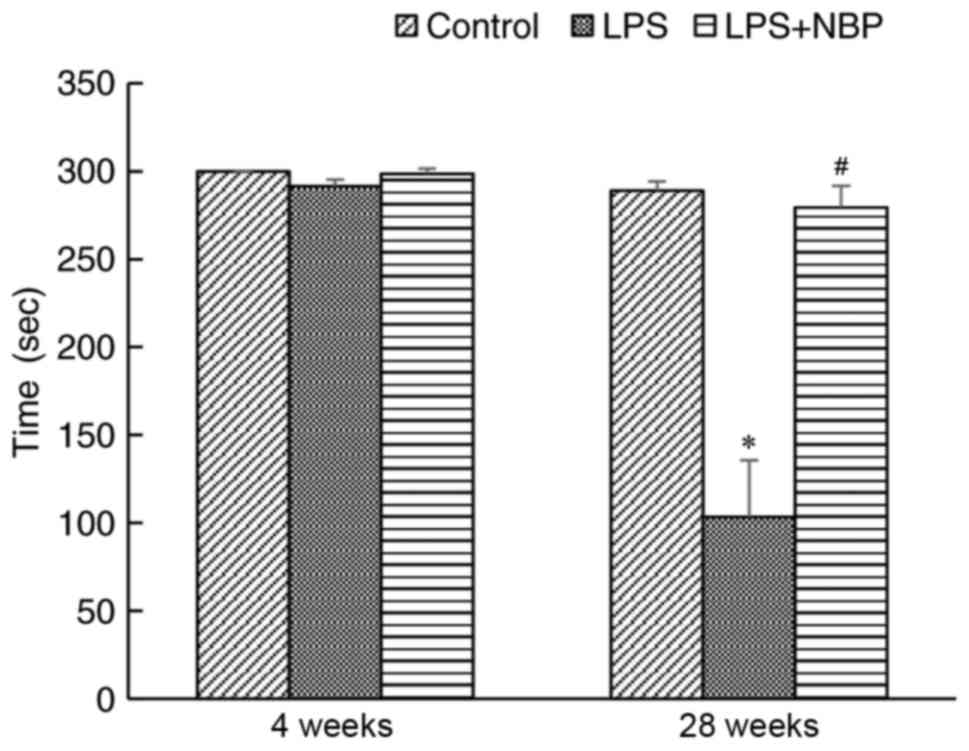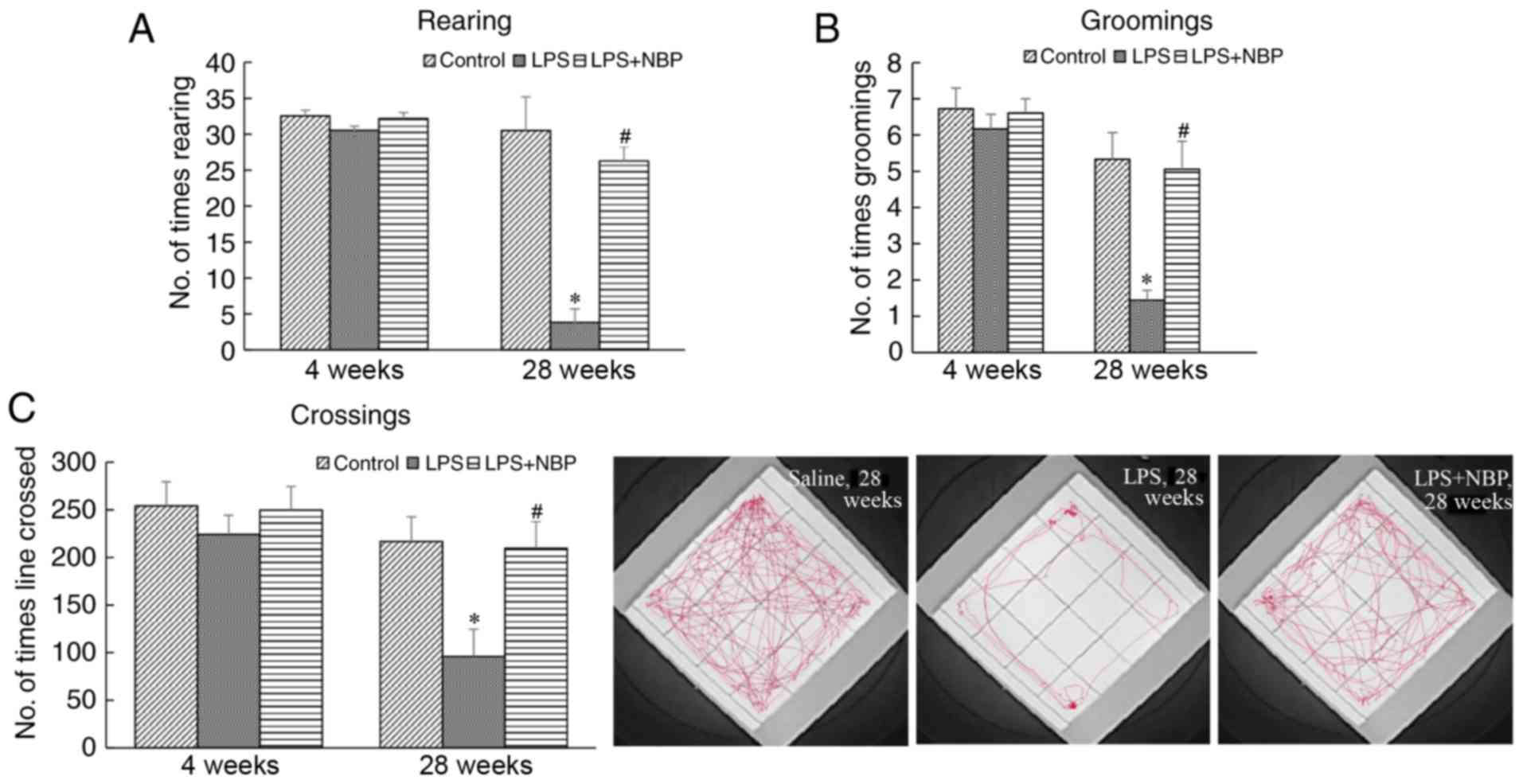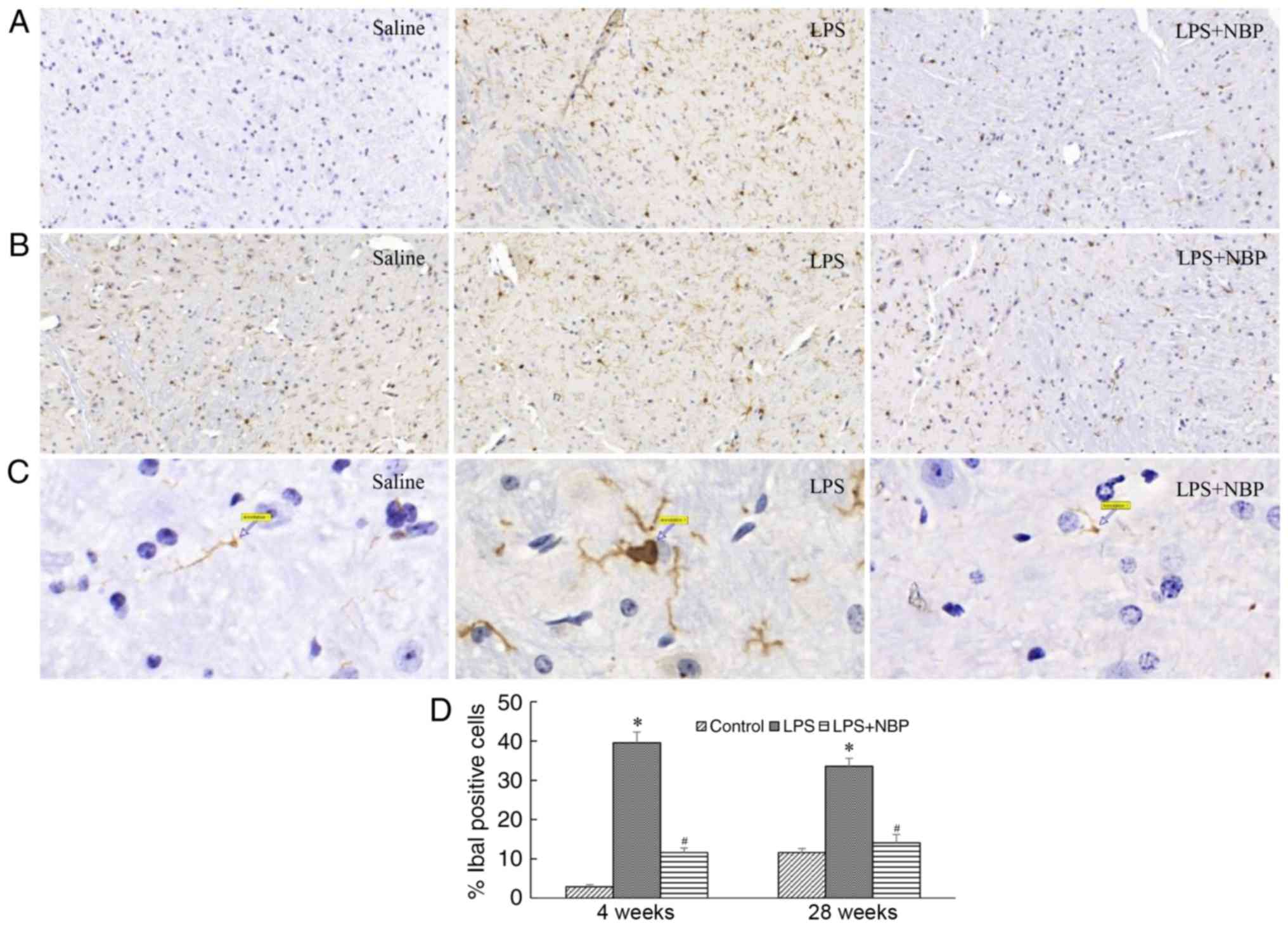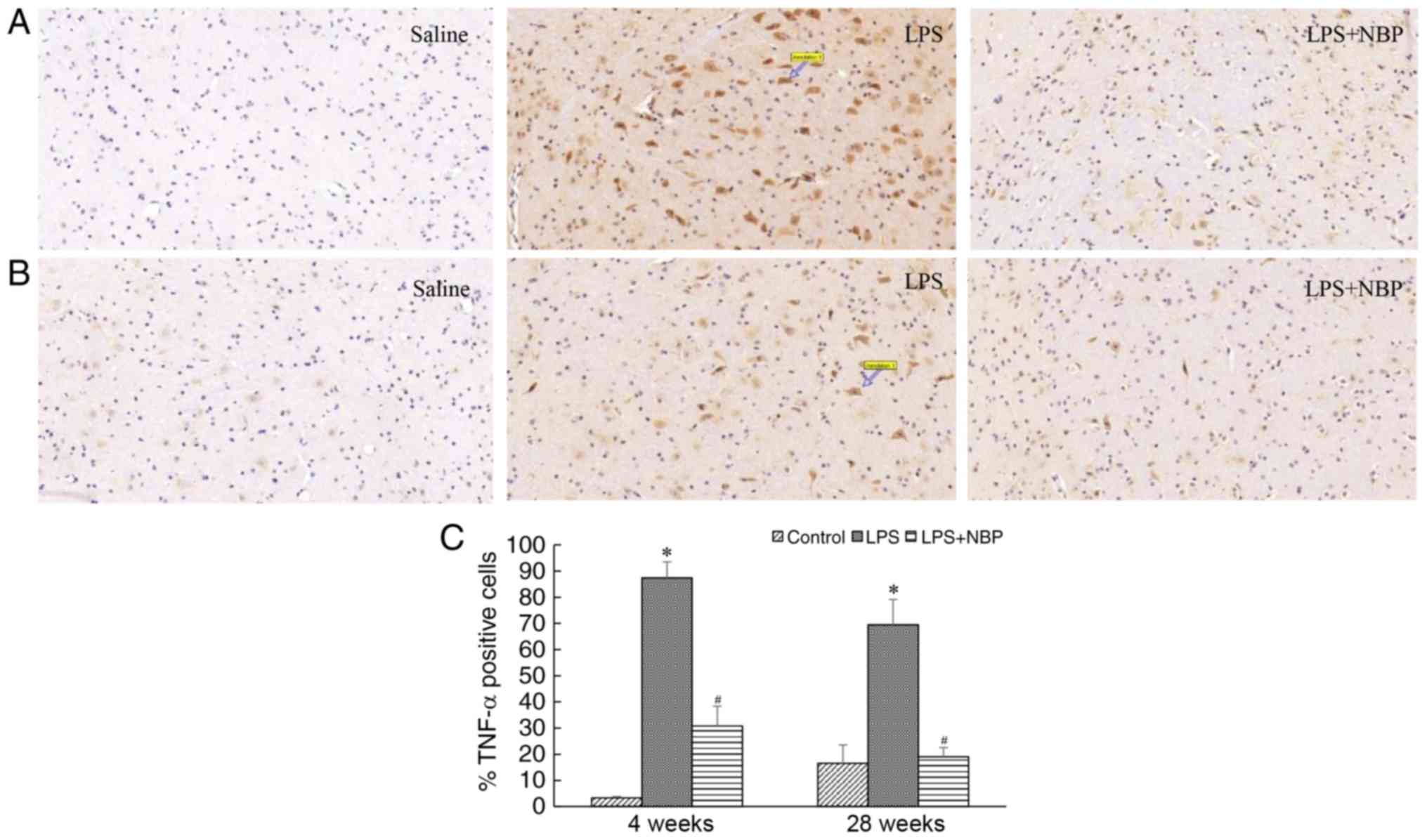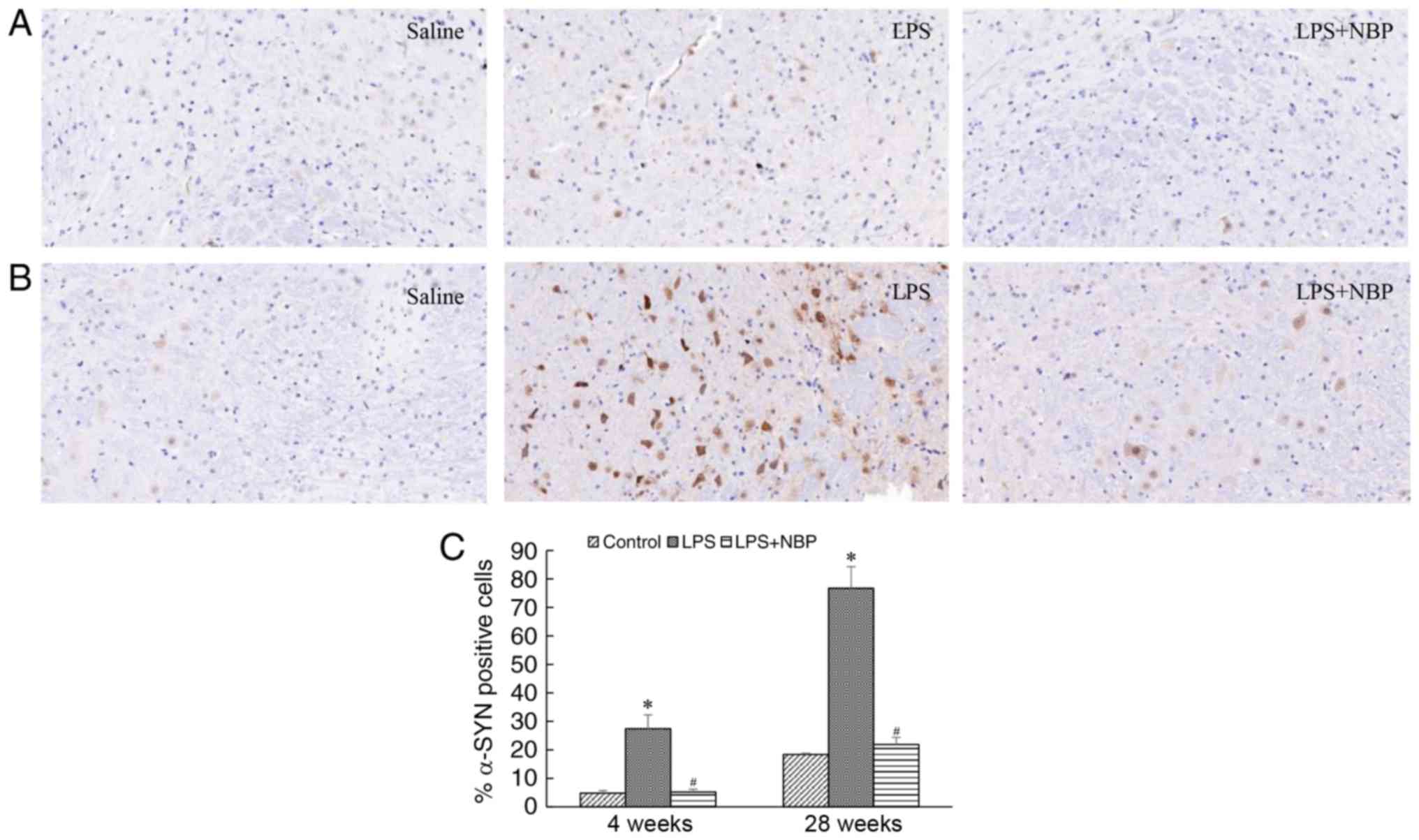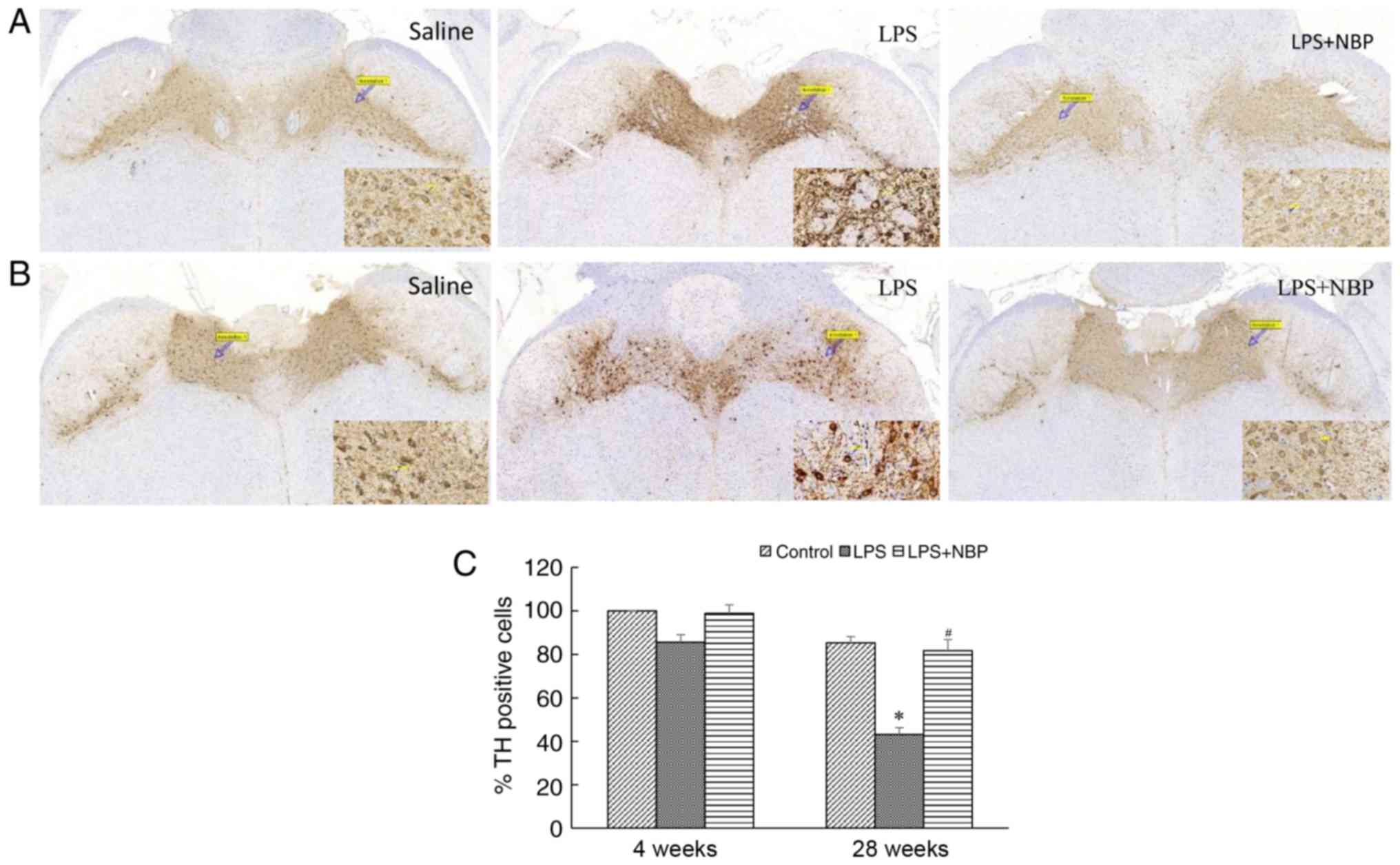DL‑3‑n‑butylphthalide reduces microglial activation in lipopolysaccharide‑induced Parkinson's disease model mice
- Authors:
- Published online on: December 20, 2017 https://doi.org/10.3892/mmr.2017.8332
- Pages: 3884-3890
Abstract
Introduction
Parkinson's disease (PD) is a progressive degenerative disease of the central nervous system characterised by the deposition of α-synuclein in the mesencephalic substantia nigra and the progressive loss of dopaminergic neurons (1). When the loss of dopaminergic neurons exceeds 50%, the level of secreted dopamine becomes insufficient, resulting in the development of movement disorders, including resting tremor, bradykinesia, muscle rigidity and gait abnormalities, which may severely affect patient quality of life and lead to mortality (2).
However, conventional medications, including levodopa, are only able to increase the dopamine content in the brain to improve symptoms, and are unable to prevent or delay disease development (3,4). In addition, long-term use may lead to uncontrollable movement side-effects and adverse drug reactions. Therefore, it is important to identify drugs that may prevent the progressive loss of dopaminergic neurons, which may help to prevent or delay the development of PD and improve patient survival.
Although the precise mechanisms underlying the development of PD remain unclear, research has demonstrated that immune-mediated inflammation is involved in PD pathogenesis (5,6). Microglia are immunocompetent cells of the brain, and the activation of microglia leads to an increase in the levels of tumour necrosis factor-α (TNF-α) (7). The pro-inflammatory factor lipopolysaccharide (LPS) is a component of the cell wall in Gram-negative bacteria that has been associated with PD. Research has demonstrated that a systemic or intracerebral injection of LPS may lead to progressive loss of dopaminergic neurons in the midbrain of normal mice, resulting in Parkinsonian-type movements as early as 28 weeks post-treatment, with increased severity by 40 weeks post-LPS exposure (8). Notably, LPS does not directly damage nerve cells; rather, it exerts its effects indirectly by activating microglia. These activated microglia, in turn, release TNF-α, leading to damage to dopaminergic neurons (9).
DL-3-n-butylphthalide (NBP) is a monomer compound isolated from celery seeds whose neuroprotective effects have been well-documented in animal models of cerebral ischaemia and vascular dementia (10). Previously, a study observed a decrease in movement and sleep disorders among 43 patients with PD who had been treated using NBP (Chen et al, unpublished data). Therefore, it was hypothesised that NBP may exert neuroprotective effects against the degeneration of substantia nigra cells via an unknown mechanism.
Therefore, the present study examined the effects of intragastric NBP administration in an LPS-induced PD mouse model. In order to elucidate the mechanism through which NBP may aid in the treatment of PD, the effects of NBP on behaviour, microglial activation, TNF-α and α-synuclein levels, and the number of tyrosine hydroxylase (TH)-positive cells in the substantia nigra were examined in model mice.
Materials and methods
Laboratory animals and treatment
A total of 36 male C57BL/6 mice, 8 weeks-old, weighing ~18–20 g [Jiangsu University, Zhenjiang, China; no. SCXK (Su) 2013–0011] were raised in a specific pathogen-free grade experimental animal facility at Bengbu Medical College [Bengbu, China; no. YXK (Anhui) 2012–002]. Each standard rearing box contained five mice. The room temperature was set at 22–24°C, 60–70% relative humidity, and the circadian cycle was set for 12/12 h light/dark. Mice were provided with ad libitum access to food and water. Experimental procedures were performed in accordance with the European Community Council Directive of 24th November 1986 (no. 86/609/EEC), and all efforts were made to minimise the pain and discomfort of animals. The present study was approved by the Ethics Committee of Bengbu Medical College.
The mice were randomly divided into three groups (n=12 mice/group). The normal control group (C) was given a single intraperitoneal injection of normal saline (NS). The model group was given a single intraperitoneal injection of LPS (5 mg/kg; Sigma-Aldrich; Merck KGaA, Darmstadt, Germany). The NBP treatment group was treated in the same manner as the model group with regard to the induction of PD; however, beginning on the day of model induction, weight-based NBP (120 mg/kg/day; NBP Pharmaceutical Co., Shijiazhuang, China) was given once daily via intragastric administration for 30 days. At weeks 4 and 28 following model induction, 6 mice from each group were randomly selected for behavioural testing, following which they were anaesthetised using 4% chloral hydrate. Thoracotomy was performed, and the right atrium was punctured with an infusion needle, which was immediately inserted into the left ventricle for rapid infusion of 0.9% NS, until the liver had turned white. Subsequently, 4% paraformaldehyde was infused over 20 min for fixation. The mid-brain containing the substantia nigra was removed and paraffin-embedded in preparation for continuous coronal sectioning.
Rotarod test
A rotarod treadmill (cat. no. ENV576; Med Associates, Inc., St. Albans, VT, USA) was used to evaluate the motor coordination of the mice. At weeks 4 and 28 following treatment, mice were placed on a rotarod and pre-trained at a constant speed over a 5-min period. During testing, the speed was increased from 2.5 to 25 rpm, and the average time of three repeated tests in which the mice remained on the rotating bar was recorded. The results are expressed as dwell time (sec).
Open field test
The field was contained within a custom-made wooden box with dimensions of 40×40×30 cm (length × width × height). The bottom and inside surface of the box were painted white, and a camera was placed above the centre of the box. The subject mouse was placed in the middle of the box, and its movements were observed and recorded for 5 min. Using a motion trajectory tracking system (Noldus Information Technology B.V., Wageningen, The Netherlands), the bottom of the test box was divided into 16 visual areas, each spanning 10×10 cm. Line crossing, rearing, and grooming activities were recorded and analysed.
Immunohistochemical staining
Immunohistochemical staining was used to determine levels of activated ionised calcium binding adaptor molecule (Iba)-1-positive cells, α-synuclein deposition and TH-positive cells in the midbrain. The midbrains, followed by 4% paraformaldehyde for 20 min at 0°C, were embedded in paraffin and sliced into coronal sections with a thickness of 4 µm each. Sections were transferred through three washes with xylene and rehydrated with decreasing grades of absolute alcohol (95, 75 and 50%). Endogenous peroxidases were blocked by incubating the sections with 3% H2O2 at room temperature for 10 min. Following antigen retrieval, the sections were incubated with the primary monoclonal antibodies anti-TH (1:1,000, cat. no. GB11181), rabbit anti-Iba-1 (1:1,000, cat. no. GB13105), TNF-α (1:200, cat. no. GB13188; all from Servicebio, Shanghai, China; www.servicebio.com) or α-synuclein (1:500, cat. no. AB1903; Abcam, Cambridge, UK) at 37°C overnight. On the following day, the sections were rinsed with PBS and incubated with the appropriate biotinylated goat anti-mouse/rabbit horseradish peroxidase-labelled antibody (1:1) (cat. no. K5007; Dako; Agilent Technologies, Inc., Santa Clara, CA, USA) at 37°C for 50 min, washed and stained with a diaminobenzidine staining kit (Dako; Agilent Technologies, Inc.). Following Harris haematoxylin staining for 3 min at room temperature and controlling the dying time under a simple microscope (magnification, ×200; Nikon Corporation, Tokyo, Japan).
Statistical analysis
All experiments were repeated twice, and all data were processed using SPSS software version 16.0 (SPSS, Inc., Chicago, IL, USA), and are expressed as the mean ± standard deviation. Multiple comparisons were performed using one-way analysis of variance followed by Tukey's post hoc test. P<0.05 was considered to indicate a statistically significant difference.
Results
Effect of NBP on rotarod performance in LPS-induced PD mice
In the present study, the rotarod experiment was used to evaluate fine motor coordination and balance in PD model mice. At 4 weeks following treatment with LPS, no significant difference was observed in dwell time among the control, LPS, and LPS + NBP groups. However, by 28 weeks, mice in the LPS group exhibited significantly shorter dwell times compared with those of the NS group (P<0.05), while NBP significantly attenuated the effects of LPS (P<0.05) (Fig. 1).
Effect of NBP on open field test performance in LPS-induced PD mice
The open field test was used to evaluate exploratory behaviour and spontaneous locomotor activities in PD model mice. Line crossing, rearing and grooming activities were recorded and analysed to determine the extent of tremor, gait instability and bradykinesia. At 28 weeks following treatment with LPS, the frequency of line crossing, rearing and grooming activities in the treatment mice had decreased (P<0.05) compared with those observed in NS mice. However, NBP significantly attenuated the effect of LPS (P<0.05) (Fig. 2). At 4 weeks, there was no marked difference among the three groups.
NPS prevents LPS-induced activation of mouse microglia
Microglia serve an important role in intracerebral inflammation. A previous study (8) has reported that microglial activation results in the degeneration of substantia nigra neurons in patients with PD. The results of the present study indicated that, compared with that observed in the control group, the number of microglia significantly increased in mice by 4 weeks post-treatment with LPS (P<0.05). These microglia tended to be larger, rounder, and exhibit amoeboid-like alterations, indicative of microglial activation. These alterations were still observed at 28 weeks following LPS treatment (P<0.05), although NBP reduced this effect of LPS on microglia at weeks 4 and 28 (P<0.05) (Fig. 3).
NBP prevents LPS-induced increases in levels of TNF-α in the mouse midbrain
TNF-α released by activated microglia is among the key inflammatory factors that lead to degeneration of substantia nigra cells. In the present study, the expression of TNF-α was demonstrated to be increased as the levels of activated microglia increased. Compared with that observed in the control group, the expression of TNF-α significantly increased in the mice of the LPS group following 4 and 28 weeks of treatment (P<0.05). However, NBP attenuated this effect of LPS at the two time-points (P<0.05) (Fig. 4).
NBP reduces LPS-induced α-synuclein deposition in the substantia nigra of the mouse midbrain
The deposition of α-synuclein is a pathognomonic change in the midbrains of patients with PD. In the present study, α-synuclein deposition was observed in the substantia nigra of mice at 4 weeks following treatment with LPS and increased over time. At week 28 post-treatment with LPS, α-synuclein deposition in the substantia nigra had significantly increased (P<0.05), although these effects were attenuated by NBP (P<0.05) (Fig. 5).
NBP protects against the LPS-induced loss of dopaminergic neurons in the substantia nigra
Loss of dopaminergic neurons in the substantia nigra represents another pathognomonic change that occurs in patients with PD. The results of the present study indicated that the number of dopaminergic neurons in the substantia nigra had decreased at 4 and 28 weeks following treatment with LPS, relative to that observed in the control group (P<0.05), and that this decrease became amplified over time. However, NBP attenuated the LPS-induced loss of neurons (P<0.05). Notably, at 28 weeks following treatment with LPS, the number of TH-positive cells in all three groups of mice had decreased, although the number of TH-positive cells in the NBP-treated group was similar to that in the control group. The results of the present study may reflect the loss of dopaminergic neurons in the substantia nigra during the aging process, suggesting that NBP may decrease neuronal loss associated with physiological aging (Fig. 6).
Discussion
In 95% of PD cases, the disease is sporadic and of the delayed type, with an unclear aetiology and no clear pattern of inheritance; in these cases, PD is considered to be associated with various factors, including environmental toxins, immune-mediated inflammation and oxidative stress (11). A previous study demonstrated that systemic inflammation-induced cerebral microglial activation is an important factor in the pathogenesis of PD (6). LPS, a cell wall component of Gram-negative bacteria, is among the proinflammatory cytokines with important roles in systemic inflammation. Previous studies have reported that systemic and intracerebral injections of LPS may lead to dopaminergic neuronal loss in the midbrain of normal mice (9,12), in addition to the activation of cerebral microglia. Such activation leads to increases in levels of inflammatory factors, including TNF-α, interleukin (IL)-6 and IL1β, following which Parkinsonian motor symptoms may be observed (9,12). A previous study indicated that LPS may cause intestinal permeability, sequential increases in α-synuclein immunoreactivity, and pathological α-synuclein accumulation in the colon in a manner similar to that observed in patients with PD (13). A mouse model of PD induced via systemic injection of LPS was selected for the present study as this animal model presents with a progressive loss of dopaminergic neurons. Such mice do not display classic PD motor symptoms until 7 months following model induction, which is more consistent with the clinical progression of PD (9). Consistent with the findings of previous studies, no obvious motor impairment was observed in the model mice in the early stages of the disease (4 weeks following model induction). Apparent motor symptoms did not develop until 28 weeks following model induction. However, the corresponding morphological alterations in the midbrain occurred 4 weeks prior to the onset of motor symptoms in the model mice. These alterations, which progressed over time, included α-synuclein deposition and a decrease in the number of dopaminergic neurons in the substantia nigra.
Notably, it was observed that microglial activation and increased TNF-α levels occurred early in the midbrains of model mice. Microglia are the primary intracerebral immune cells and serve an important role in intracerebral inflammation. Recent studies have indicated that immune-mediated inflammation is involved in the pathogenesis of PD (12). However, LPS does not directly damage neurons; rather, it does so by activating microglia. In a previous study, when midbrain neurons were cultured in vitro, oxidopamine (6-OHDA) decreased the number of TH-positive cells by 89%, while LPS had no obvious effect on TH-positive cells. However, when neurons and microglia were cultured together, 6-OHDA only reduced the number of TH-positive cells by 27%, while LPS reduced this number by 70% (14). Subsequent studies have demonstrated that LPS may induce microglial activation and release proinflammatory cytokines, including nitric oxide, TNF-α, IL-6 and IL1β, which are known to cause dopaminergic neuronal damage (15). These previous findings suggested that LPS is among the causes of microglial activation in the brains of patients with PD, leading to the release of proinflammatory cytokines and cytotoxins. Such alterations may, in turn, promote the inflammatory response of dopaminergic neurons in the substantia nigra, resulting in dopaminergic neuronal injury.
In the present study, it was observed that NBP inhibited the activation of microglia and decreased α-synuclein deposition and the loss of dopaminergic neurons in the substantia nigra of LPS-induced PD mice. NBP, also termed butylphthalide (C12H14O2; molecular mass, 190) is an active ingredient isolated from the oil of celery seeds with multiple pharmacological effects (16–18), though the mechanisms underlying these effects remain unknown. NBP is a national class I chemical drug with independent intellectual property rights in China. Clinical studies have demonstrated that NBP is a safe and effective treatment for ischaemic stroke (10). In a mouse model of spinal lateral sclerosis, NBP decreased the levels of glial cell activation and the intracerebral expression of nuclear factor-κB, transcription factor p65, and TNF-α, prolonging the survival time of mice (16). In a murine model of cerebral ischaemia-reperfusion, NBP decreased the intracerebral levels of TNF-α and intracellular adhesion molecule-1, thereby reducing damage to brain tissue (17). In a rotenone-induced PD mouse model, NBP decreased damage to dopaminergic neurons in the midbrain (18). In accordance with these findings, the results indicated that 30 days of treatment with NBP during the establishment of an LPS-induced model significantly attenuated LPS-induced mesencephalic microglial activation in the early stages, and decreased the loss of dopaminergic neurons in addition to α-synuclein deposition in the substantia nigra in the late stages. Additionally, 7 months post-treatment, the number of dopaminergic neurons in the substantia nigra of the NBP-treated group was significantly increased compared with the LPS-treated group, and was similar to that of the control group, likely for two reasons: i) NBP treatment was administered during model induction, promptly preventing the activating effect of LPS on microglia; and ii) the model was established when the mice were 6-weeks old, and they had reached middle age (34-weeks old) by 7 months following model establishment. Physiological aging is associated with a loss of dopaminergic neurons, as aging cells cause chronic inflammatory responses that damage nearby cells. Indeed, chronic inflammation, aging and age-associated diseases are associated with one another. NBP treatment was commenced when the mice were 6-weeks old and was continued until they were 10-weeks old. Thus, the treatment may have prevented chronic inflammation induced by the aging of dopaminergic neurons, although the specific mechanism of action and the targets involved require further investigation.
The present study possesses a limitation of note, as the mechanism through which NBP blocks the LPS-induced activation of microglia was not investigated in vivo. Future studies are required to investigate the role of NBP in the inflammatory pathway of microglial cells in vitro.
In conclusion, the results of the present study demonstrated that systemic application of LPS is able to induce the early activation of microglial cells in the mouse brain, thereby leading to intracerebral inflammation, progressive loss of dopaminergic neurons in the substantia nigra and α-synuclein deposition. These alterations are associated with PD motor symptoms. In addition, the results of the present study indicated that NBP may prevent LPS-induced activation of microglia and preserve dopaminergic neurons in the substantia nigra. NBP thus exhibits potential as a treatment for neurodegenerative diseases, including PD.
Acknowledgements
The present study was supported by the National Natural Science Foundation of China (grant no. 81641050).
Glossary
Abbreviations
Abbreviations:
|
LPS |
lipopolysaccharide |
|
NBP |
dl-3-n-butylphthalide |
|
TH |
tyrosine hydroxylase |
|
PD |
Parkinson's disease |
|
Iba-1 |
ionised calcium binding adaptor molecule-1 |
|
TNF-α |
tumour necrosis factor-α |
|
IL |
interleukin |
|
6-OHDA |
oxidopamine |
References
|
Venda LL, Cragg SJ, Buchman VL and Wade-Martins R: α-Synuclein and dopamine at the crossroads of Parkinson's disease. Trends Neurosci. 33:559–568. 2010. View Article : Google Scholar : PubMed/NCBI | |
|
Calabresi P and Di Filippo M: Multitarget disease-modifying therapy in Parkinson's disease? Lancet Neurol. 14:975–976. 2015. View Article : Google Scholar : PubMed/NCBI | |
|
Peterson DS, Pickett KA and Earhart GM: Effects of levodopa on vividness of motor imagery in parkinson disease. J Parkinsons Dis. 2:127–133. 2012.PubMed/NCBI | |
|
Gagne JJ and Power MC: Anti-inflammatory drugs and risk of Parkinson disease: A meta-analysis. Neurology. 74:995–1002. 2010. View Article : Google Scholar : PubMed/NCBI | |
|
Lema Tomé CM, Tyson T, Rey NL, Grathwohl S, Britschgi M and Brundin P: Inflammation and α-synuclein's prion-like behavior in Parkinson's disease-is there a link? Mol Neurobiol. 47:561–574. 2013. View Article : Google Scholar : PubMed/NCBI | |
|
Grozdanov V, Bliederhaeuser C, Ruf WP, Roth V, Fundel-Clemens K, Zondler L, Brenner D, Martin-Villalba A, Hengerer B, Kassubek J, et al: Inflammatory dysregulation of blood monocytes in Parkinson's disease patients. Acta Neuropathol. 128:651–663. 2014. View Article : Google Scholar : PubMed/NCBI | |
|
Fernández-Calle R, Vicente-Rodríguez M, Gramage E, Pita J, Pérez-García C1, Ferrer-Alcón M, Uribarri M, Ramos MP and Herradón G: Pleiotrophin egulates microglia-mediated neuroinflammation. J Neuroinflammation. 14:462017. View Article : Google Scholar : PubMed/NCBI | |
|
Alhadidi Q and Shah ZA: Cofilin mediates LPS-induced microglial cell activation and associated neurotoxicity through activation of NF-κB and JAK-STAT pathway. Mol Neurobiol. Feb 13–2017.(Epub ahead of print). View Article : Google Scholar : PubMed/NCBI | |
|
Qin L, Wu X, Block ML, Liu Y, Breese GR, Hong JS, Knapp DJ and Crews FT: Systemic LPS causes chronic neuroinflammation and progressive neurodegeneration. Glia. 55:453–462. 2007. View Article : Google Scholar : PubMed/NCBI | |
|
Cui LY, Zhu YC, Gao S, Wang JM, Peng B, Ni J, Zhou LX, He J and Ma XQ: Ninety-day administration of dl-3-n-butylphthalide for acute ischemic stroke: A randomized, double-blind trial. Chin Med J (Engl). 126:3405–3410. 2013.PubMed/NCBI | |
|
Gan-Or Z, Dion PA and Rouleau GA: Genetic perspective on the role of theautophagy-lysosome pathway in Parkinson disease. Autophagy. 11:1443–1457. 2015. View Article : Google Scholar : PubMed/NCBI | |
|
Hoban DB, Connaughton E, Connaughton C, Hogan G, Thornton C, Mulcahy P, Moloney TC and Dowd E: Further characterisation of the LPS model of Parkinson's disease: A conparison of intra-nigral and intra-striatal lipopolysaccharide administration on motor function, microgliosis andnigrostriatal neurodegeneration in the rat. Brain Behav Immun. 27:91–100. 2013. View Article : Google Scholar : PubMed/NCBI | |
|
Kelly LP, Carvey PM, Keshavarzian A, Shannon KM, Shaikh M, Bakay RA and Kordower JH: Progression of intestinal permeability changes and alpha-synuclein expression in a mouse model of Parkinson's disease. Mov Disord. 29:999–1009. 2014. View Article : Google Scholar : PubMed/NCBI | |
|
Bronstein DM, Perez-Otano I, Sun V, Mullis Sawin SB, Chan J, Wu GC, Hudson PM, Kong LY, Hong JS and McMillian MK: Glia-dependent neurotoxicity and neuroprotection in mesencephalic cultures. Brain Res. 704:112–116. 1995. View Article : Google Scholar : PubMed/NCBI | |
|
Xing B, Xin T, Hunter RL and Bing G: Pioglitazone inhibition of lipopolysaccharide-induced nitric oxide synthase is associated with altered activity of p38 MAP kinase and PI3K/Akt. J Neuroinflammation. 5:42008. View Article : Google Scholar : PubMed/NCBI | |
|
Feng X, Peng Y, Liu M and Cui L: DL-3-n-butylphthalide extends survival by attenuating glial activation in a mouse model of amyotrophic lateral sclerosis. Neuropharmacology. 62:1004–1010. 2012. View Article : Google Scholar : PubMed/NCBI | |
|
Xu HL and Feng YP: Inhibitory effects of chiral 3-n-butylphthalide on inflammation following focal ischemic brain injury in rats. Acta Pharmacol Sin. 21:433–438. 2000.PubMed/NCBI | |
|
Hua K, Sheng X, Li TT, Wang LN, Zhang YH, Huang ZJ and Ji H: The edaravone and 3-n-butylphthalide ring-opening derivative 10b effectively attenuates cerebral ischemia injury in rats. Acta Pharmacol Sin. 36:917–927. 2015. View Article : Google Scholar : PubMed/NCBI |



